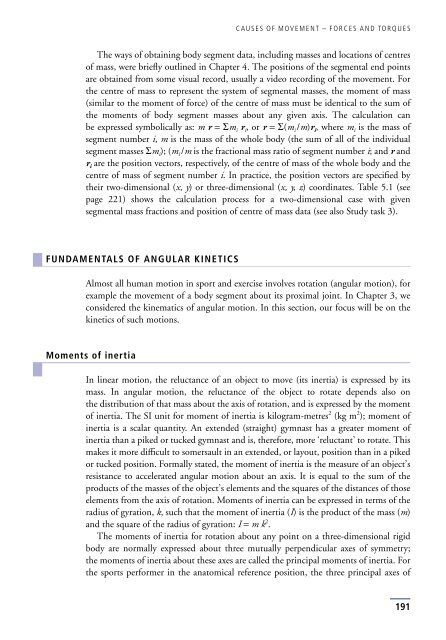Introduction to Sports Biomechanics: Analysing Human Movement ...
Introduction to Sports Biomechanics: Analysing Human Movement ...
Introduction to Sports Biomechanics: Analysing Human Movement ...
Create successful ePaper yourself
Turn your PDF publications into a flip-book with our unique Google optimized e-Paper software.
The ways of obtaining body segment data, including masses and locations of centres<br />
of mass, were briefly outlined in Chapter 4. The positions of the segmental end points<br />
are obtained from some visual record, usually a video recording of the movement. For<br />
the centre of mass <strong>to</strong> represent the system of segmental masses, the moment of mass<br />
(similar <strong>to</strong> the moment of force) of the centre of mass must be identical <strong>to</strong> the sum of<br />
the moments of body segment masses about any given axis. The calculation can<br />
be expressed symbolically as: m r = Σm i r i, or r = Σ(m i /m)r i, where m i is the mass of<br />
segment number i, m is the mass of the whole body (the sum of all of the individual<br />
segment masses Σm i); (m i/m is the fractional mass ratio of segment number i; and r and<br />
r i are the position vec<strong>to</strong>rs, respectively, of the centre of mass of the whole body and the<br />
centre of mass of segment number i. In practice, the position vec<strong>to</strong>rs are specified by<br />
their two-dimensional (x, y) or three-dimensional (x, y, z) coordinates. Table 5.1 (see<br />
page 221) shows the calculation process for a two-dimensional case with given<br />
segmental mass fractions and position of centre of mass data (see also Study task 3).<br />
FUNDAMENTALS OF ANGULAR KINETICS<br />
Almost all human motion in sport and exercise involves rotation (angular motion), for<br />
example the movement of a body segment about its proximal joint. In Chapter 3, we<br />
considered the kinematics of angular motion. In this section, our focus will be on the<br />
kinetics of such motions.<br />
Moments of inertia<br />
CAUSES OF MOVEMENT – FORCES AND TORQUES<br />
In linear motion, the reluctance of an object <strong>to</strong> move (its inertia) is expressed by its<br />
mass. In angular motion, the reluctance of the object <strong>to</strong> rotate depends also on<br />
the distribution of that mass about the axis of rotation, and is expressed by the moment<br />
of inertia. The SI unit for moment of inertia is kilogram-metres 2 (kg m 2 ); moment of<br />
inertia is a scalar quantity. An extended (straight) gymnast has a greater moment of<br />
inertia than a piked or tucked gymnast and is, therefore, more ‘reluctant’ <strong>to</strong> rotate. This<br />
makes it more difficult <strong>to</strong> somersault in an extended, or layout, position than in a piked<br />
or tucked position. Formally stated, the moment of inertia is the measure of an object’s<br />
resistance <strong>to</strong> accelerated angular motion about an axis. It is equal <strong>to</strong> the sum of the<br />
products of the masses of the object’s elements and the squares of the distances of those<br />
elements from the axis of rotation. Moments of inertia can be expressed in terms of the<br />
radius of gyration, k, such that the moment of inertia (I) is the product of the mass (m)<br />
and the square of the radius of gyration: I = m k 2 .<br />
The moments of inertia for rotation about any point on a three-dimensional rigid<br />
body are normally expressed about three mutually perpendicular axes of symmetry;<br />
the moments of inertia about these axes are called the principal moments of inertia. For<br />
the sports performer in the ana<strong>to</strong>mical reference position, the three principal axes of<br />
191






